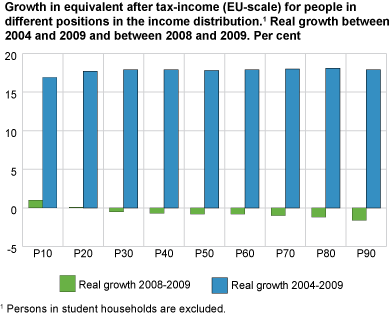Content
Published:
This is an archived release.
Moderate decline in inequality
Households at the top of the distribution experienced a decline in after-tax income in 2009. As a consequence, the income distribution narrowed. Reduced property income and income from self-employment were the main contributors to the reduction in top incomes.
For the second year in a row there was a moderate decline in income inequality in Norway. The main explanation behind this trend is a reduction in household incomes at the top of the distribution.
Top decile holds 20 per cent of total income
The share of total household income received by the top decile decreased from 20.8 per cent in 2008 to 20.2 per cent in 2009. The share of income received by the bottom decile was 4 per cent in 2009. This was the same share as the previous year.
People at the bottom of the distribution were the only ones to experience a real growth in household income in 2009, while people at the top of the distribution had the sharpest fall in income in real terms.
In a longer perspective, the income growth is distributed evenly across the income distribution. Except for the 10. percentile, which grew by 17 per cent in fixed prices between 2004 and 2009, all other percentiles increased their income by 18 per cent.
Tables:
- Table 1 Distribution of household equivalent income after taxes, between persons. (EU-scale). Decile shares and cumulative decile shares. 1986-2009. Persons in student households are excluded. Per cent
- Table 2 Measures of income despersion. Household equivalent income (EU-scale) between persons. 1986-2009
- Table 3 Composition of total household income within decile groups for household equivalent income after taxes between persons. (EU-scale). Share of total income. 1990, 1995, 2000, 2005, 2006, 2007, 2008 and 2009. Per cent
- Table 4 Household equivalent income (EU-scale), for different percentiles of the income distribution. 2009-NOK
The statistics is published with Income and wealth statistics for households.
Contact
-
Statistics Norway's Information Centre
E-mail: informasjon@ssb.no
tel.: (+47) 21 09 46 42

